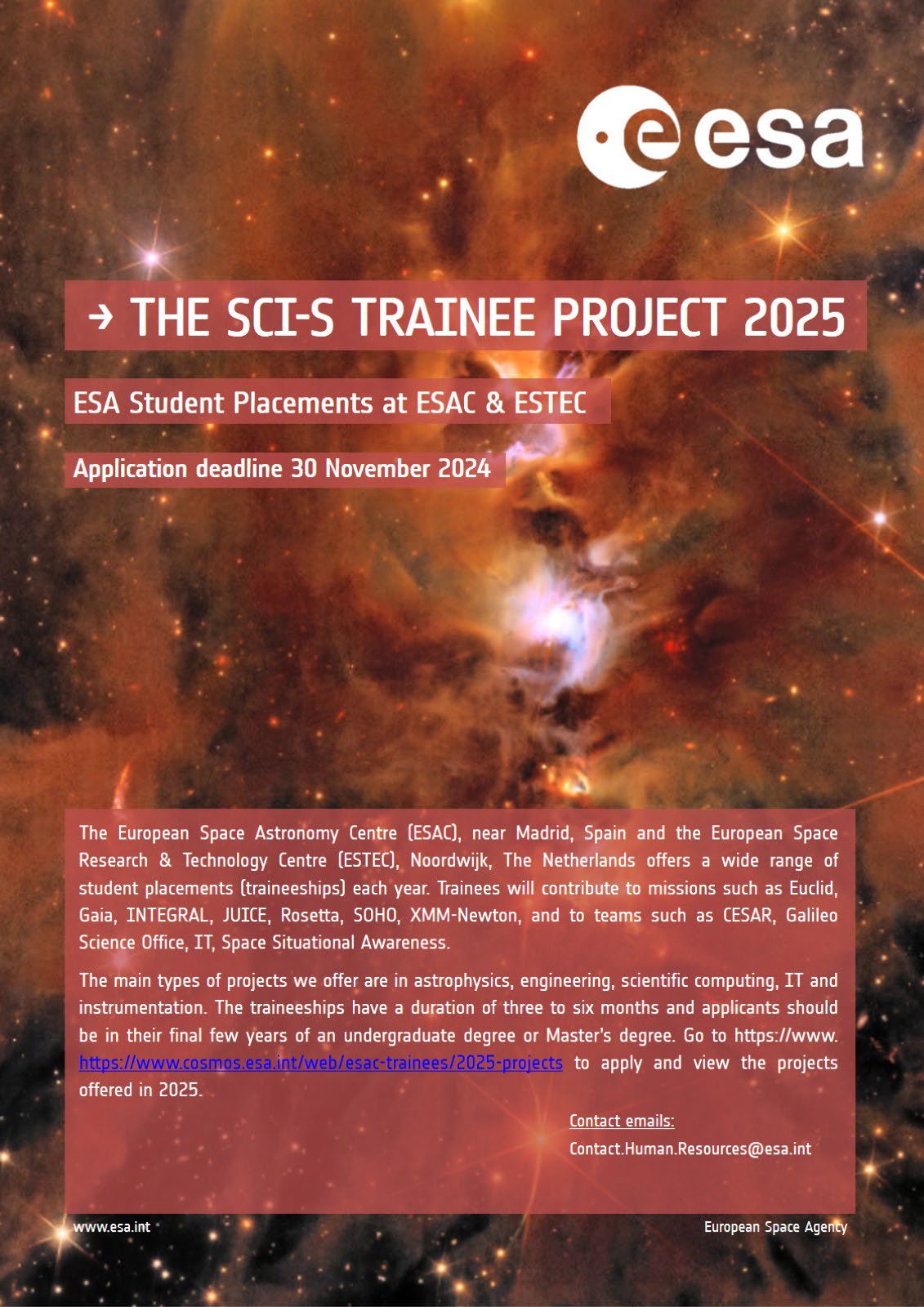Training Opportunities - ESAC Trainees
|
|
Training Opportunities
The application for student internships in 2025 will start 1st November!
List of our projects can be found here.
|
|
Who can apply?
-
To apply you must be a national of an ESA Member State or one of its Cooperating States. Member States include: Austria, Belgium, the Czech Republic, Denmark, Estonia, Finland, France, Germany, Greece, Hungary, Ireland, Italy, Luxembourg, the Netherlands, Norway, Poland, Portugal, Romania, Spain, Sweden, Switzerland and the United Kingdom. Nationals from Latvia, Lithuania and Slovenia, as Associate Members, or Canada as a Cooperating State, can apply as well as those from Bulgaria, Cyprus and Slovakia as European Cooperating States. Studying in an ESA member state does not contribute to your eligibility for an ESA traineeship.
-
Applicants should be in the last few years of their Bachelors degree or be studying a Master's degree. You need to have student status and be enrolled at university for the entire duration of the internship (either undergradute or Master's student). For recent graduates, we refer you to the ESA Young Graduate Trainee scheme and the ESA National Trainee scheme. For PhD and Post-docs, we refer you to the Open Space Innovation Platform (OSIP) and the ESA Research Fellowships.
Conditions
- Internships last from three to six months.
- Internships are unpaid, however, a monthly allowance of €800 for non-residents and €500 for residents is granted. A non-resident is defined as someone living more than 50 km from the establishment. The non-resident allowance will also be granted to students with special needs, irrespective of their residency status.
- Interns are responsible for their own health insurance, accident insurance and travel expenses.
- Interns are responsible for finding their own accommodation.
Further information on ESA Trainee Programmes can be found here.
How to apply
Opportunities are published in November each year and remain open for a month. You can set up a job alert to be informed as soon as the opportunities are published!
- Once published, you will be able to browse the ESA list of opportunities here.
- Select the one that best matches your interests and profile.
- To apply, you first have to register and create your candidate profile with your CV and motivation letter.
- Once you have applied, you will be able to track the status of your application.
To see the descriptions of this year projects please go here.
Applications are accepted through an online application form, which is available here.
You will be contacted shortly after the deadline if you have been invited for an interview. There will be an interview day organised at ESA, where you will have the opportunity to talk to each tutor of the projects of your interest. If you will not be able to come to ESA a remote interview will be organised.
Recruitment timeline
- November: call for applications,
- December/January: shortlisting and selection of candidates,
- February: earliest start date for internships. The take-up-duty date is set by mutual agreement taking into account preferences included in your application form and can be any time from February to October of the same year.
All candidates will be informed of the outcome of their application.
How to get to ESAC
Instructions on how to get to ESAC can be found here (in English), here (in Spanish), and also on the XMM-Newton pages.
How to get to ESTEC
Instructions on how to get to ESTEC can be found here (in English).
Additional Information
Each year between fifteen to twenty projects are advertised. All project durations are between a minimum of three months and a maximum of six months. The types of projects we offer are astrophysics, engineering, instrumentation, education projects etc (all SCI-S activities).
See the following for the types of projects advertised in previous years:
The ESAC Trainee Project is part of the ESA Student Placement scheme and is organised and funded by ESA Human Resources and the Science Operations Department, in collaboration with the Space Science Faculty and the ESA Education Office.
- Removed a total of (3) style text-align:center;
- Removed a total of (3) style text-align:justify;
- Removed a total of (4) align=center.
- Removed a total of (1) align=right.
- Removed a total of (3) border attribute.
- Removed a total of (3) cellpadding attribute.
- Removed a total of (3) cellspacing attribute.








































 Sign in
Sign in
 Science & Technology
Science & Technology


